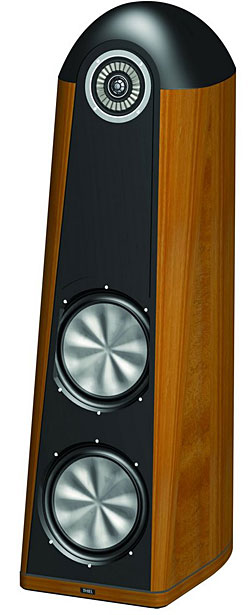| Columns Retired Columns & Blogs |
Thiel CS3.7 loudspeaker
One might argue that Thiel Audio's 3-series loudspeakers are the audio equivalents of BMW's 3-series sports cars: relatively affordable, but 100% about performance. Thiel has made bigger, more expensive loudspeakers than the 3s, as well as smaller, less expensive models—but the iconic Thiels are the 3s.
 I also suspect that they're Jim Thiel's favorites, although he'd probably never admit it. When he spoke to me about the new CS3.7 at the Consumer Electronics Show a few years ago, he almost choked up when he said, "I've wanted to revisit the 3s for a while now..." I could almost see him pondering le temps perdus. Of course, in the years since designing the CS3.6, he'd worked on the CS5.1, the CS7.2, the PowerPoints, and makeovers of the CS2.3 and CS1.5 (respectively, the CS2.4 and CS1.6), in addition to practically reinventing the category of subwoofers. It's not as if the man hasn't been busy.
I also suspect that they're Jim Thiel's favorites, although he'd probably never admit it. When he spoke to me about the new CS3.7 at the Consumer Electronics Show a few years ago, he almost choked up when he said, "I've wanted to revisit the 3s for a while now..." I could almost see him pondering le temps perdus. Of course, in the years since designing the CS3.6, he'd worked on the CS5.1, the CS7.2, the PowerPoints, and makeovers of the CS2.3 and CS1.5 (respectively, the CS2.4 and CS1.6), in addition to practically reinventing the category of subwoofers. It's not as if the man hasn't been busy.
On the other hand, Thiel says, he probably couldn't have built the CS3.7 much sooner. "We could have never built the '3.7s the 'old' way, buying drivers from OEM companies," he said. "We had to engineer them ourselves—in fact, we had to design them ourselves, and then master the engineering. And, having better drivers, we needed to make the cabinets more rigid."
In other words, you could say that it took a lifetime to build the CS3.7—the lifetime of Jim Thiel.
If you want to be happy for the rest of your life
While the CS3.7 ($12,900/pair) is different from its predecessors, Thiel didn't exactly start with a blank sheet of paper. "It had to be time and phase coherent, and it had to have a first-order crossover. Since it would replace the '3.6, I wanted it to be a three-way, so you could say that before I designed it, I knew a lot about it—everything except how to do it."
The CS3.7 is recognizably a Thiel. It has the raked-back baffle common to all floorstanding Thiels, but unlike its brethren, the '3.7 has a curved body constructed of 15 layers of laminated hardwood (not MDF) and capped by a cast-aluminum nacelle. The cap not only reinforces the cabinet's strength, it also optimizes diffraction. The front baffle is of machined aluminum.
The speaker's looks have been the source of some comment chez Wes. I look at them and see Daleks from Dr. Who, albeit Daleks without grating voices. My wife says they're elegant. She's got a good eye (he says smugly).
The CS3.7 is a three-way, despite looking like a two-way design. A coincidentally arranged midrange-tweeter assembly is mounted above a 10" woofer, and a 10" passive radiator. All the drive-units were designed by Jim Thiel and all are manufactured to his specifications, but Thiel suggests that his biggest breakthrough is the 4.5" midrange driver, which is not a cone. Its aluminum diaphragm resembles a flattened, corrugated doughnut—the tweeter nests into the center, where the dustcap would go in a conventional design. On examination, the "corrugations" prove to be radial lobular indentations in the aluminum.
"This allows us to use a very thin diaphragm that operates pistonically—very close to ideally," said Thiel. "It's linear up to around 20kHz, which is unheard of." That's not simply because of the driver's complex shape, however. The diaphragm is driven by a massive 3" voice-coil and a powerful neodymium magnet, which give it "exceptional circumferential strength."
The 1" aluminum-dome tweeter, too, is new. It has five neodymium magnets (four magnetized radially, one axially), which, Thiel said, "exert enough brute force to raise sensitivity and reduce distortion." He also pointed out that, mounted as it is inside an essentially flat driver rather than a shallow cone, the tweeter doesn't suffer from the "shouty" coloration that plagues many coincidentally mounted tweeters.
The woofer is another essentially flat driver with radially mounted strengthening lobes. It, too, boasts a 3" voice-coil and a massive (5-lb) magnet. Like the midrange driver, it also employs Thiel's long-gap, short-coil drive system, which keeps the coil within a uniform magnetic field throughout its entire range. Jim Thiel believes that "most" loudspeaker distortion is caused by the voice-coil experiencing fluctuations in the magnetic field as it gets farther from the magnetic gap. A short coil, a humongous magnet, and a copper "focusing" sleeve on the voice-coil former ameliorate the problem, he says.
As always, the crossover is first-order and complex. It's a Thiel, after all.
The queerest folks of all
Setup was relatively simple—as simple as manipulating a slippery, asymmetrical, 45"-tall, 91-lb object can be. I sited the CS3.7s 5' from the front wall and 21" from the sidewalls. I sat 91" away, with my ears about 4" below the tweeter axis. (Thiel says the ideal position is "at least 2" below the tweeter's axis.") I then screwed in the CS3.7's massive floor spikes. If you have small children or a large pet, Thiel offers "stabilizer" bars that outrig the spikes, giving the speakers a larger footprint. Even with the Chaos Kitties gamboling in the listening room, I never worried about the '3.7s taking a fall, so I didn't need the outriggers.
- Log in or register to post comments




































